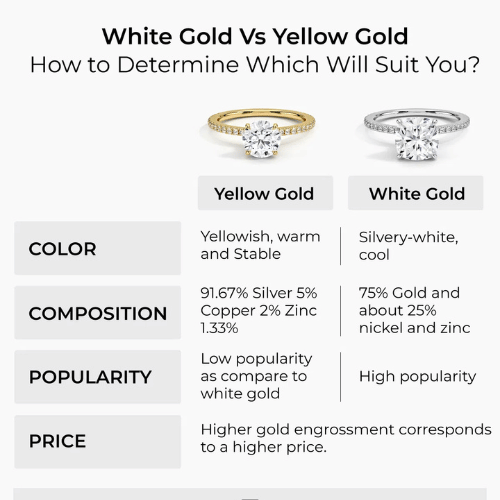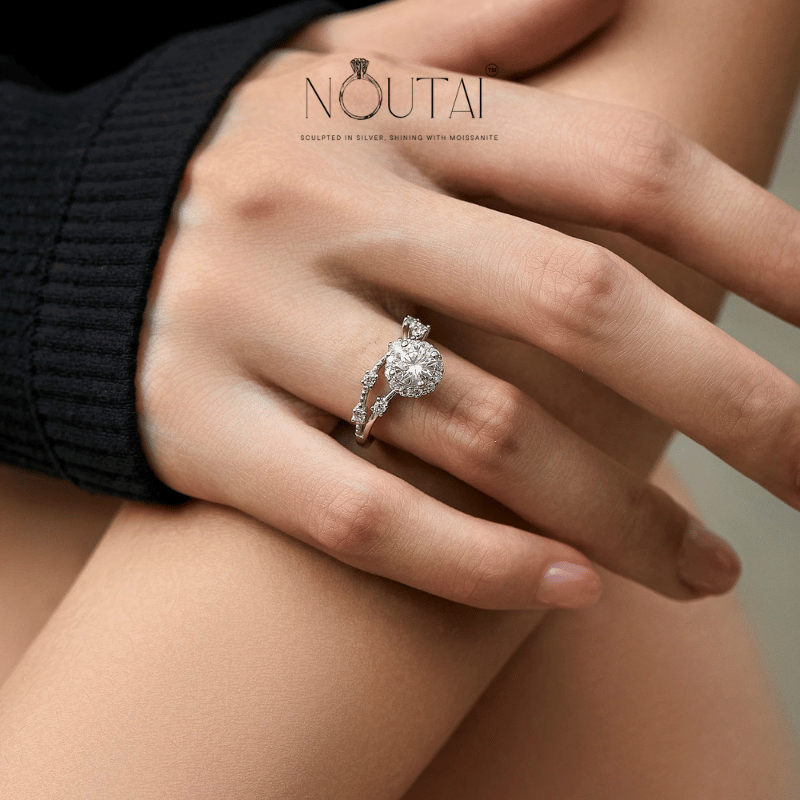When shopping for the perfect diamond, understanding diamond clarity ratings is essential to making an informed decision. Diamond clarity refers to the absence of internal inclusions and external blemishes, which significantly impact both a diamond's beauty and its value. But what exactly is diamond clarity, and how do you choose the best clarity for your budget and preferences? In this blog, we break down everything you need to know about diamond clarity ratings to make the right choice.
What Are Diamond Clarity Ratings?
Diamond clarity rating measures how clean a diamond is from internal inclusions and external blemishes. The Gemological Institute of America (GIA) created the diamond clarity scale, which ranges from Flawless (FL) to Included (I3). The higher the clarity grade, the fewer imperfections the diamond contains, resulting in better light performance and overall beauty.
What is the Best Diamond Clarity?
The best diamond clarity depends on your priorities and budget. While FL (Flawless) and IF (Internally Flawless) diamonds represent the highest clarity grades, they come with a premium price tag. Many experts consider VS1 and VS2 clarity diamonds to be the sweet spot, offering excellent clarity that appears flawless to the naked eye at a more accessible price point. All lab-grown diamonds we offer start at VS1 clarity, ensuring you receive a diamond with exceptional clarity characteristics.
Diamond Clarity Ratings Chart: Comparing All Clarity Grades
Here's a comprehensive breakdown of each diamond clarity grade and how they compare to one another:
What is an FL (Flawless) Diamond?
Flawless (FL) diamonds are the rarest clarity grade, showing no inclusions or blemishes even under 10x magnification by a skilled grader. These diamonds represent absolute perfection in clarity.
FL vs IF (Internally Flawless): While both are exceptional, FL diamonds have no external blemishes, whereas IF diamonds may have minor surface blemishes visible under magnification.
What is an IF (Internally Flawless) Diamond?
Internally Flawless (IF) diamonds contain no internal inclusions when examined under 10x magnification but may have minor surface blemishes. These diamonds still represent extraordinary quality.
IF vs VVS1 Diamond Clarity: IF diamonds offer the best diamond clarity with absolutely no internal inclusions, while VVS1 diamonds have extremely slight inclusions that are challenging even for experienced gemologists to locate.
What is a VVS1 Diamond?
VVS1 (Very, Very Slightly Included 1) diamonds have inclusions that are extremely difficult for skilled gemologists to see under 10x magnification. These inclusions are typically so tiny and well-positioned that they're virtually invisible.
VVS1 vs VVS2 Diamond Clarity: Both VVS1 and VVS2 diamonds have minute inclusions, but VVS1 inclusions are slightly smaller, fewer, or better positioned than those in VVS2 diamonds.
What is a VVS2 Diamond?
VVS2 (Very, Very Slightly Included 2) diamonds have minute inclusions that are very difficult for gemologists to locate under 10x magnification but may be slightly more visible than those in VVS1 diamonds.
VVS2 vs VS1 Diamond Clarity: VVS2 inclusions are more difficult to find under magnification compared to VS1 inclusions, though both appear flawless to the naked eye.
What is a VS1 Diamond?
VS1 (Very Slightly Included 1) diamonds have minor inclusions that can be detected under 10x magnification but remain invisible to the naked eye. All of our lab-grown diamonds meet or exceed this clarity grade.
VS1 vs VS2 Diamond Clarity: VS1 inclusions are typically smaller, fewer, or better positioned than VS2 inclusions, though both grades appear clean to the unaided eye.
What is a VS2 Diamond?
VS2 (Very Slightly Included 2) diamonds have minor inclusions that are somewhat easy for a gemologist to spot under 10x magnification but remain invisible to the naked eye in most cases.
VS2 vs SI1 Diamond Clarity: VS2 inclusions are less noticeable than SI1 inclusions. While VS2 inclusions are almost always invisible without magnification, some SI1 inclusions may be visible to the naked eye in larger stones.
What is an SI1 Diamond?
SI1 (Slightly Included 1) diamonds have noticeable inclusions that are easy to see under 10x magnification. In smaller stones, these inclusions typically remain invisible to the naked eye.
SI1 vs SI2 Diamond Clarity: SI1 inclusions are less obvious than SI2 inclusions, with a lower likelihood of being visible without magnification or affecting the diamond's brilliance.
What is an SI2 Diamond?
SI2 (Slightly Included 2) diamonds have inclusions that are easily noticeable under 10x magnification and may be visible to the naked eye, particularly in larger stones.
SI2 vs I1 Diamond Clarity: SI2 inclusions are still considered minor compared to the more significant inclusions found in I1 diamonds, which often affect the stone's appearance.
What is an I1 Diamond?
I1 (Included 1) diamonds have inclusions that are obvious under 10x magnification and often visible to the naked eye. These inclusions may affect the diamond's transparency and brilliance.
I1 vs I2 Diamond Clarity: I1 diamonds have noticeable inclusions, but they're less severe than those found in I2 diamonds, which significantly impact appearance and brilliance.
What is an I2 Diamond?
I2 (Included 2) diamonds have prominent inclusions that are easily visible to the naked eye and significantly affect the diamond's brilliance and transparency.
I2 vs I3 Diamond Clarity: I2 inclusions, while significant, are less severe than the very prominent inclusions in I3 diamonds, which can impact durability.
What is an I3 Diamond?
I3 (Included 3) diamonds have large, obvious inclusions that are easily visible to the naked eye and severely impact the diamond's brilliance, transparency, and potentially its durability.

How to Choose the Best Diamond Clarity for Your Budget
When selecting diamond clarity ratings, consider these factors:
-
Visual appearance: VS1 and higher clarity diamonds appear flawless to the naked eye.
-
Size of the diamond: Larger diamonds may show inclusions more readily than smaller ones.
-
Diamond shape: Step-cut diamonds like emerald and asscher cuts reveal inclusions more easily than brilliant cuts.
-
Setting style: Certain settings can help hide minor inclusions.
-
Budget considerations: Moving down one clarity grade can offer significant savings with minimal visual difference.
Why Choose Lab-Grown Diamonds?
Our Noutai Official Store offer exceptional clarity with a minimum VS1 rating, ensuring brilliant, beautiful stones that are optically and chemically identical to mined diamonds. By choosing our lab-grown diamonds, you're selecting a more affordable alternative that doesn't compromise on quality while making a more sustainable choice than mined diamonds.
Our diamonds are set in recycled gold, further enhancing their appeal for those seeking more sustainable fine jewelry options without sacrificing quality or beauty.
Whether you're drawn to the brilliant sparkle of moissanite or our stunning lab-grown diamonds, you can be confident that you're receiving the best diamond clarity, exceptional sparkle, and outstanding value.
Diamond Clarity FAQs
What is the best diamond clarity for engagement rings?
For engagement rings, VS1 and VS2 diamond clarity grades offer the best value, appearing flawless to the naked eye while being more affordable than higher clarity grades.
Can diamond clarity affect brilliance?
Yes, lower clarity grades (particularly I1-I3) can reduce a diamond's brilliance as inclusions may interfere with light performance.
Does diamond clarity rating affect value?
Absolutely. Diamond clarity is one of the four Cs (cut, color, clarity, and carat) that determine a diamond's value, with higher clarity diamonds commanding higher prices.
Is VS1 or VS2 diamond clarity better?
VS1 is technically better than VS2, but both appear flawless to the naked eye. VS2 often represents better value for most consumers.
What diamond clarity rating is eye-clean?
Generally, diamonds with VS2 clarity and above are considered "eye-clean," meaning inclusions aren't visible without magnification. Some SI1 diamonds can also be eye-clean, especially in smaller sizes.



